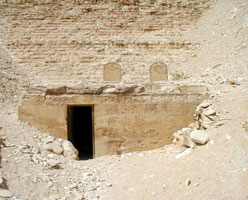The pyramid of Meidum is one of the three pyramids ascribed to Sneferu (the other two being the Bent Pyramid and the Red Pyramid at Dashur). It is often known as the “collapsed pyramid” because of its ruined state. By the fifteenth century, the Egyptian historian al-Maqrizi recorded that only five steps remained and by the time it was surveyed by Napoleon’s men only three steps were still in place. It is known as “el-haram el-kaddab” (the “False Pyramid”) in Arabic because it now barely resembles a pyramid.

Like other pyramids, it was built in accretion layers. However, unlike other pyramids a smooth outer layer was added to each level. It was Borchardt who first realised that this was because the pyramid was built in three stages with the design altering at each point. It was originally designed as a seven step pyramid with a further step being added once construction was in a fairly advanced stage. It was then turned into the first true pyramid by filing in the steps and capping them with limestone. The last layer, therefore, rested not on solid rock but rather on three layers of limestone blocks and sand.
During the first two stages of building, the blocks were angled towards the middle of the pyramid (as was done with the Pyramid of Djoser) which increased stability. However, in the final stage blocks were laid horizontally, which both reduced the cohesion of the layers of the monument and made the work of stone thieves easier.
From the entrance on the north face an unusually high fifteen meters above ground level, a steep passage descends to meet a horizontal passage just below ground level. This passage has two small niches, on the east and west walls, the purpose of which is not clear. The corridor connects with a vertical shaft which rises ten meters to meet a small burial chamber. The burial chamber is the first to have been cut into the core of the pyramid and, to bear the weight of masonry above, it has a corbelled roof.


When Maspero first entered the burial chamber he found ropes and beams which he thought may have been left by tomb robbers. Others suggested they related to a burial in the pyramid, but no sarcophagus was found inside the chamber and there is no evidence that Sneferu or anyone else was ever buried in this pyramid. Petrie recorded finding the remains of a wooden coffin possibly dating to the Old Kingdom, but he provided no specific evidence of this and his notes are a little confused on the matter.
The mortuary temple was the first example to be built on the east side rather than the north, and although it is a simple building it is fairly well preserved. The whole complex is surrounded by an enclosure wall, traces of which remain.
On the east side of the large open courtyard created by this wall there was a large mastaba possibly intended for the Crown Prince. On the south side of the courtyard there is a ruined satellite pyramid which is the oldest known example of a cult pyramid. The entrance on the north face leads down to a small burial chamber in which fragments of a limestone stele bearing the image of Horus were found. On the opposite side of the courtyard was another small mastaba, possibly for the queen.


There was also a causeway cut into the bedrock and paved with limestone but this is largely ruined. It would most likely have run around two hundred meters to connect with the valley temple at the edge of the Nile, but due to the marshy nature of the ground and the high water level no evidence of this building has been found.
It is sometimes suggested that the Meidum pyramid was begun as a step pyramid by Huni but completed by Sneferu. Experts were tempted to ascribe the pyramid to Huni partly because he is not associated with any other large pyramid or mastabas; although he may have built one or more of the seven small pyramids stretched from Seila to Elephantine. However, the Meidum pyramid was named “Sneferu Endures” and it is surrounded by a number of mastabas in which the sons of Sneferu were buried, so it seems reasonable to ascribe it entirely to him.
When the pyramid was complete it is estimated that its proportions were similar to those of the Great Pyramid but it is likely that the pyramid began to crumble during the reign of Sneferu and that this may have contributed to his decision to alter the angle of his pyramid at Dashur in mid construction. There is some evidence that the pyramid was built within the first fifteen years of his reign and then he abandoned Meidum for Dashur.
It is tempting to see this pyramid as a practice run for his later, better constructed, pyramids at Dashur. Ricke has suggested that the myth of Osiris was incorporated into the worship of the dead king at around this time and that this caused a theological shift towards solar rather than stellar religion which in turn altered the form of the pyramid from step to true and the orientation away from North-South to East-West. Wildung has gone as far as to suggest the Meidum pyramid is a precursor to the sun temples the Fifth Dynasty pharaohs built near Abusir.
Bibliography
- Dodson, Aiden (2016) The Royal Tombs of Ancient Egypt
- Lehner, Mark (1997) The Complete Pyramids
- Malek, Jaromir (2000) “The Old Kingdom”, in The Oxford History of Ancient Egypt Ed I. Shaw
- Verner, Miroslav (1997) The Pyramids
Copyright J Hill 2015